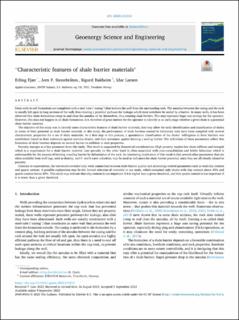| dc.contributor.author | Fjær, Erling | |
| dc.contributor.author | Stenebråten, Jørn | |
| dc.contributor.author | Bakheim, Sigurd | |
| dc.contributor.author | Larsen, Idar | |
| dc.date.accessioned | 2024-04-11T08:02:13Z | |
| dc.date.available | 2024-04-11T08:02:13Z | |
| dc.date.created | 2023-11-06T14:15:27Z | |
| dc.date.issued | 2023 | |
| dc.identifier.citation | Geoenergy Science and Engineering. 2023, 231: 212312. | en_US |
| dc.identifier.issn | 2949-8929 | |
| dc.identifier.uri | https://hdl.handle.net/11250/3125978 | |
| dc.description.abstract | Deep wells in soft formations are completed with a steel tube (“casing”) that isolates the well from the surrounding rock. The annulus between the casing and the rock is usually left open in long sections of the well, thus creating a potential pathway for leakage which must somehow be sealed by a barrier. In many wells, it has been observed that shale formations creep in and close the annulus all by themselves, thus creating shale barriers. This may represent huge cost savings for the operator. However, this does not happen in all shale formations. It is therefore of great interest for the operator to identify at an early stage whether a given shale is a potential shale barrier material. The objective of this study was to identify some characteristic features of shale barrier materials, that may allow for early identification and classification of shales in terms of their potential as shale barrier material. In this study, the performance of shale barriers created in laboratory tests have been compiled with several characteristic properties for a set of shale materials. As a first step in this process, a quantitative classification of the shales' willingness to form barriers was established, based on their resistance against annulus closure, and their resistance against forming a sealing barrier. The definitions of these parameters reflect that formation of shale barriers depends on several factors in addition to rock properties. Porosity emerges as a key parameter from this study. This result is supported by theoretical considerations. High porosity implies low shear stiffness and strength which is a requirement for a shale barrier material. Low porosity on the other hand is often associated with over-consolidation and brittle behaviour which is unfavourable for the process of forming a sealing barrier by deformation of the rock. An interesting implication of this result is that several other parameters that are often available from well logs, such as density, and P- and S-wave velocities, may be used as indicators for shale barrier potential, since they are all closely related to porosity. Contrary to expectations, the test results revealed only weak connection between shale barrier quality and mineralogy related parameters such as total clay content and quartz content. A possible explanation may be the limited selection of materials in our study, which contained only shales with clay content above 45% and quartz content below 30%. This result may indicate that clay content is less important if it is higher than a given threshold, and that quartz content is less important if it is lower than a given threshold. | en_US |
| dc.language.iso | eng | en_US |
| dc.publisher | Elsevier | en_US |
| dc.rights | Navngivelse 4.0 Internasjonal | * |
| dc.rights.uri | http://creativecommons.org/licenses/by/4.0/deed.no | * |
| dc.title | Characteristic features of shale barrier materials | en_US |
| dc.title.alternative | Characteristic features of shale barrier materials | en_US |
| dc.type | Peer reviewed | en_US |
| dc.type | Journal article | en_US |
| dc.description.version | publishedVersion | en_US |
| dc.rights.holder | © 2023 The Authors. Published by Elsevier. | en_US |
| dc.source.pagenumber | 11 | en_US |
| dc.source.volume | 231 | en_US |
| dc.source.journal | Geoenergy Science and Engineering | en_US |
| dc.identifier.doi | 10.1016/j.geoen.2023.212312 | |
| dc.identifier.cristin | 2192698 | |
| dc.relation.project | Norges forskningsråd: 280650 | en_US |
| dc.source.articlenumber | 212312 | en_US |
| cristin.ispublished | true | |
| cristin.fulltext | original | |
| cristin.qualitycode | 2 | |

